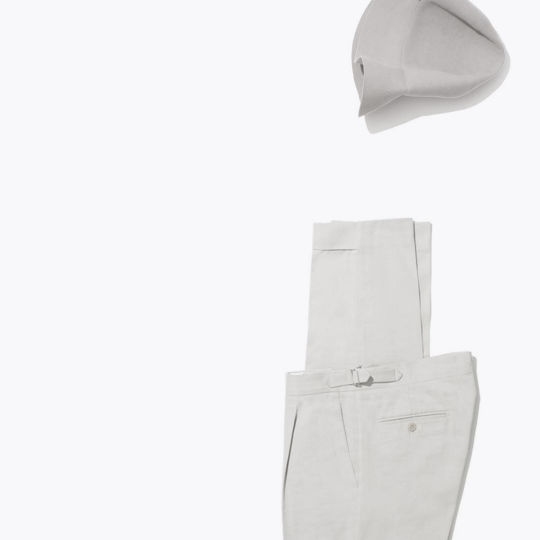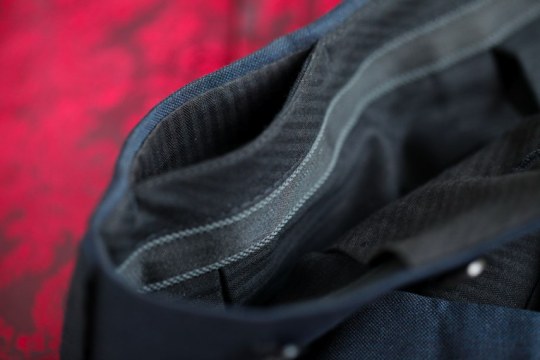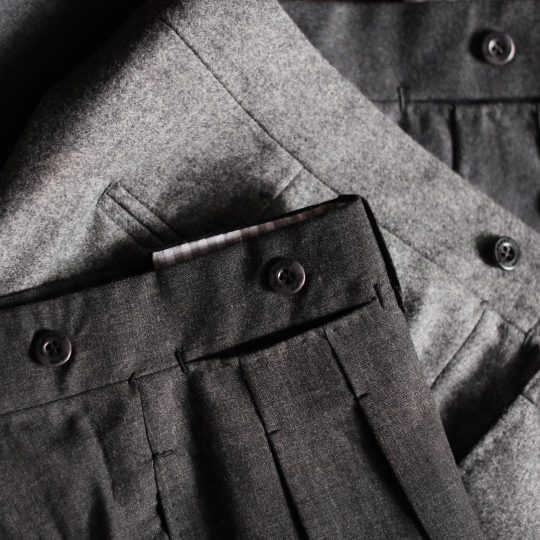
There are a lot of great menswear videos, but for my money, none beat this clip of President Lyndon B. Johnson ordering six pairs of summer trousers. It was recorded in 1964, like all White House phone calls at the time. In it, you can hear the President talking to his tailor, Joe Haggard, about how he’d like his new trousers made in very specific, anatomic detail:
“Another thing is the crotch, down where your nuts hang. It’s always a little too tight. So when you make ‘em up, give me an inch so I can let them out there – cause they cut me; it’s just like riding a wire fence. These are the best I’ve had anywhere in the United States, but when I gain a little weight, they cut me under there. You never do have much margin, but see if you can’t leave me an inch from where the zipper (burppp) ends, round back to my bunghole.”
I’ve never specified bunghole measurements to my tailor, but I have gotten pretty picky about my trousers over the years. One of the nice things about custom-made clothing is that you start from scratch. Details that you never really considered in ready-to-wear can now be fussed over. Should you get flat fronts or pleats? Belt loops or side tabs? What about Daks? When are cuffs appropriate? A lot of this is personal preference, but in case anyone found it helpful, I thought I’d lay out my own logic for these things.
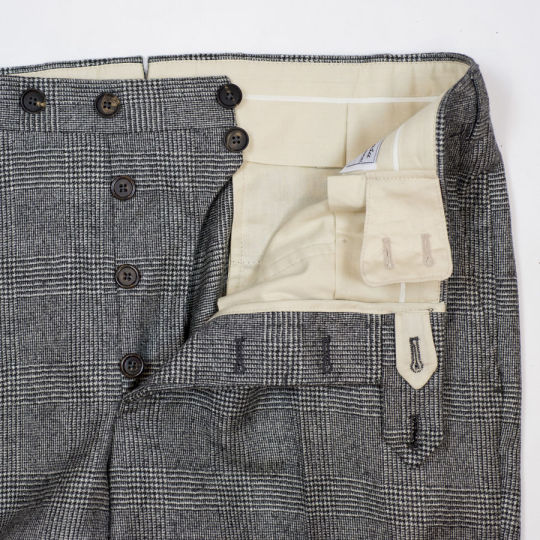

There are some things I get on every order. For one, I think button flies are better than zips because they help you avoid that dreaded “pants tent” – the bunching that can happen around your lap when you sit down. Granted, they take longer to do up, which may not be ideal if you go to the bathroom often. In which case, maybe you’re of an age where the suggestive look of a crotch tent isn’t such a bad thing (queue this famous clip on Curb Your Enthusiasm).
Then there are the pockets. I like a single back pocket on all my trousers, just because I’m used to the look in ready-to-wear. Many bespoke customers, however, prefer no pockets for a cleaner appearance. You get an uninterrupted line, don’t have any issues with pocket bags, and the trousers will be easier to alter in the future. Once back pockets are cut, an alterations tailor will be limited in how much he or she can change the seat.
Almost all hip pockets are either on-seam or sightly slanted foward. On-seam pockets go straight up and down, following the side seam of the trousers. They give a cleaner look, but it’s not always easy to slide your hand into them, which is why many like a slanted cut. My preference nowadays is for a slanted hip pocket, but with a side seam that follows the pocket opening (see the trousers above on Colin Heywood, Managing Director at Anderson & Sheppard). This is the default cut at A&S, and an ingenious solution that allows you to get the best of both worlds.
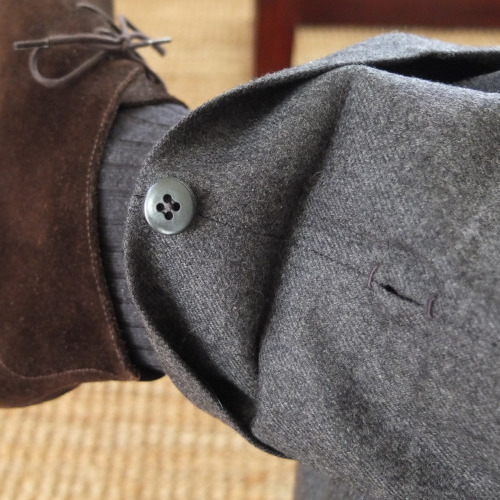
Like almost everything here, cuffs are largely a personal preference, although there are some basic rules-of-thumb. Plain hems can look a little sleeker and more modern, whereas cuffs can be traditional and old school. Pleated pants almost cry out for them, while flat fronts can go either way. If anything, I suggest always getting cuffs when in doubt (unless you’re looking at very formal trousers, such as tuxedo pants). You can always take cuffs out, but you can’t always put them in.
I get two-inch cuffs on all my trousers, along with the button detail you see above (photo from Gus). It’s a small, but useful feature. This allows you to unbutton the cuffs when you need, so you can brush out any debris. The ones above were made by Salvatore Ambrosi, who’s made the detail his signature, although I can’t imagine why you wouldn’t be able to do this as an alteration in ready-to-wear.
Similarly, on the subject of cuffs, a slanted hem – known as a military or Guardsman hem – can be a nice way to create a cleaner leg line around the back. This way, your trousers cover the back of your shoes, which I think gives a more elegant appearance. Unfortunately, this isn’t always possible, depending on your trousers. You can’t always get an angled hem on ready-to-wear pants if you also want cuffs (plain hems are easy). In bespoke, a military hem should be possible either way.
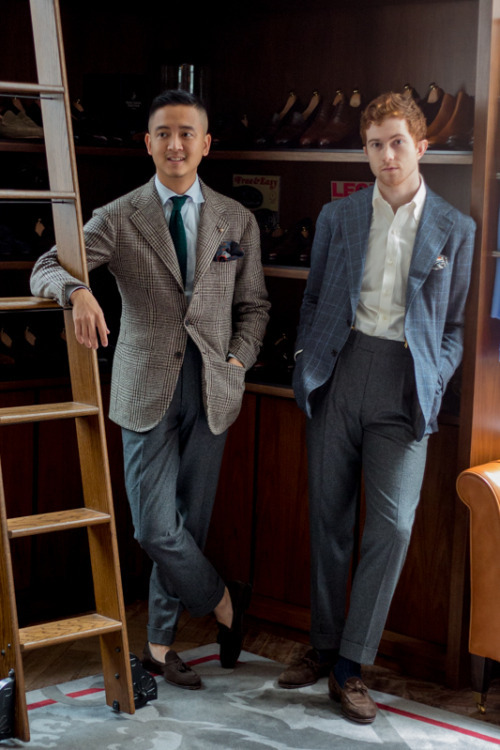
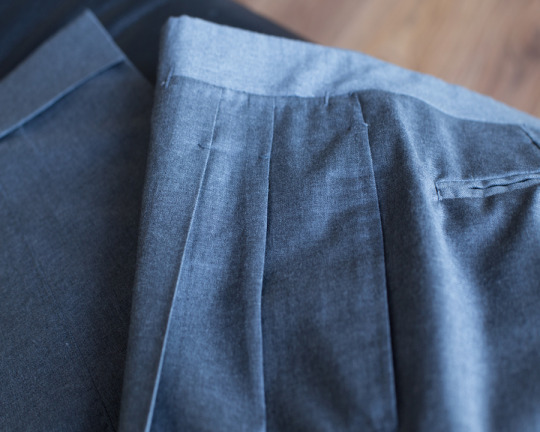
Those are the easy, standard details I put into every order. The rest – such as pleats, belt loops, suspender buttons, etc. – are a bit tricker.
For me, everything starts with whether I’ll be wearing the trousers with a tailored jacket. A higher, more traditional rise gives better proportions to a suit or sport coat ensemble, but it can look a bit fuddy-duddy on its own. Just look at Cary Grant above. Without a jacket, such trousers can leave a bit too much fabric around the lap, which is why things such as chinos are sometimes better when they sit a touch lower towards the hips.
The rise determines everything else. If it’s high, I prefer pleats over flat fronts, if only because they help visually break up the expanse of fabric around the lap (nice even if you’re wearing a jacket). Forward pleats look a bit more English and help keep a clean, straight line down a creased leg. Reverse pleats, on the other hand, feel a bit more Italian and casual. If you’re unsure about pleats, get the second. When made shallow, they look a little more like flat fronts. Personally, I get forward pleats on formal business suits, but reverse please on all but the most casual pants.
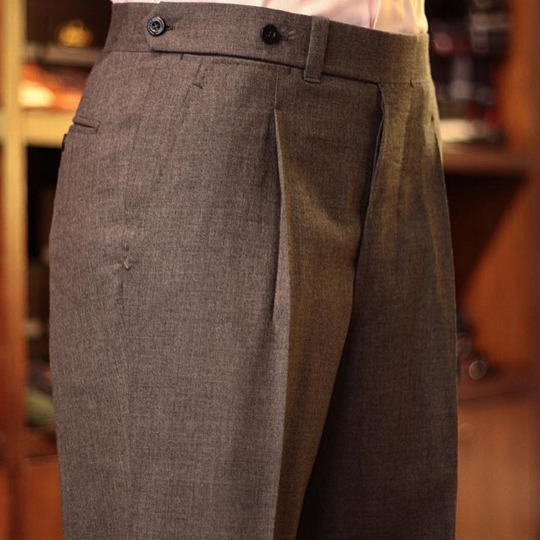

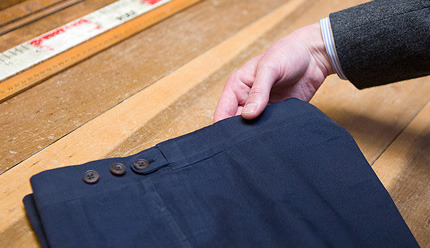
The rise also determines the waist. I prefer lower rise trousers to have belt loops, as then belts give another opportunity to accessorize. Higher rise trousers, however, often look cleaner and better with suspenders, side tabs, or a Daks waistband – a term given to side buttons that attach to a strip of elastic stretching around the back of half the waist. The upside to these non-belted systems is that they’re more comfortable. Whereas a belt creates a fixed waist, side tabs and buttons allow you to wear the waist a little looser – giving you the accommodation necessary for that extra order of sides during dinner.
If you don’t think you’ll ever wear your trousers with suspenders, consider asking for a softer waistband. You need stiff waistbands to hold suspenders, but otherwise, a soft interlining can be more comfortable when sitting down. Similarly, side tabs are often more comfortable when they set along the waist seam. This puts them at the hip bone and, more importantly, allows you to gain an extra inch in the rise.
In this way, I think of trousers in terms of two categories. More formal trousers are made with a higher rise, then cut with shallow pleats and a clean waist (i.e. no belt loops). Casual pants, on the other hand, can sit lower on the waist, as well as be made with a flat front and belt loops (although side tabs or buttons can also be fine). The key is to think about the trouser fabric and whether you’ll always be wearing the pants with a tailored jacket. When made right, certain trousers can be just as easily worn with a sport coat as they can with more contemporary and casual outerwear.
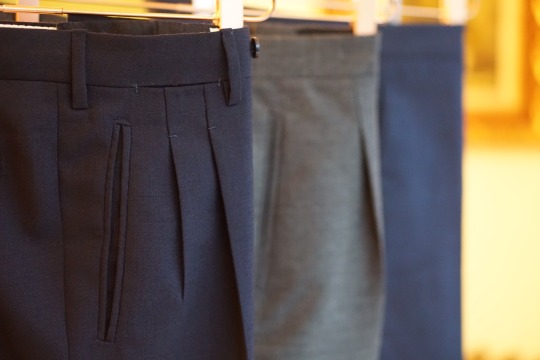
There are other details if you’re looking for something more stylistically unique. An extended waist tab, shown a few photos up, can be nice for a more Southern Italian look. Tall waistbands are also popular right now with Italian tailoring enthusiasts, although I can’t say I’m a fan. Ghurka closure systems, however, are great.
Frog mouth and welted pockets can also be great, depending on the fabric. The first lends a more causal feel to something like linen or cotton trousers, whereas the second can look particularly good on pleated pants. The ones above are from my friend Pete in San Francisco. The angular, welted pockets here do a nice job of accenting the pleats.
Then there are the things below: a fishtail back and continuous waistband (the second also known as a Hollywood waist, as it was popular with Hollywood stars in the mid-century). Both are cut for trousers worn with suspenders. Stoffa also makes pants with what they call a “half cuff” – where the cuff only comes up on the front half of the hem. Agyesh, the owner and designer behind the company, says he took the idea from a pair of school boy trousers he saw in a friend’s closet. It’s a nice detail that looks surprisingly natural on casual pants.
Lastly, tailors can also put in hidden pockets, if you need. The most common is the concealed cash pocket set along the waistband (shown in the last photo below). If you’re getting trousers with suspender buttons, however, be careful. If not done carefully, sometimes a tailor can sew the buttons through this concealed pocket.
Of course, half the fun in all this is finding your own preferences. The rules here aren’t as strict as they are for tailored jackets, which means you have a lot more freedom in choosing your own details. President LBJ went as far as thinking about how these things related to his bunghole.


